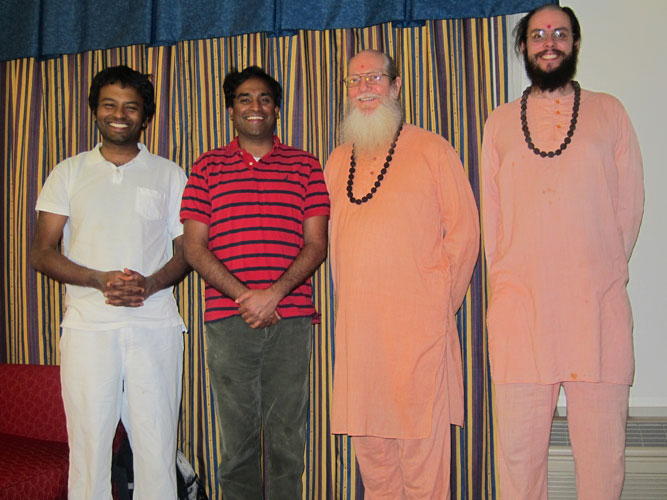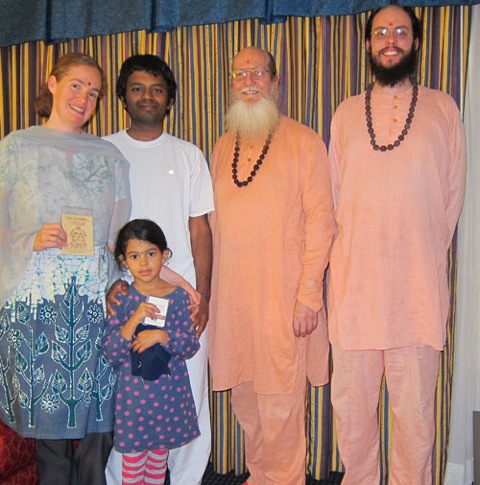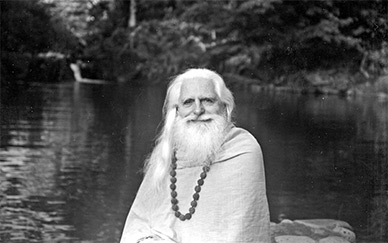Swamis Meet Janahan in Los Angeles

Shanmuganathaswami and Siddhanathaswami reunited with our friend and priest Janahan Balasingam. Mayuran Muttulingam (in white) is a cousin of Janahan and joined us for some lively discussions. Janahan performed the first annual Mahasamadhi puja for Gurudeva on October 26, 2003. See the TAKA archive for that day: TAKA Archive Oct 26 2003
Sadasivanathanswami and Sadhaka Satyanatha Visit Somnathpur
On a flight today from Delhi to Bangalore, and taking the opportunity to share our visit to a special temple.
Sri Sivaratree Desikendra Swami asks his aides to take the two Hawaii sadhus on a temple excursion, visiting several, but none to match this one: The Keshava Temple at Somnathpur. That's Harsha Babu on the left, our noble and eloquent guide (he speaks 8 Indian languages, and throws words around in English like a victorian scholar: cynosure and such.
Outside is a monolithic kodimaram, flagpole, a giant one.Inside, well, inside lies the most spectacular carving virtuosity we have ever encountered. Every carving we have seen before, well...From Wikipedia:
Somanathapuraalso known as Somnathpur) is a town located 35 km from Mysore city in Mysore district, Karnataka, India. Somanathapura is famous for the Chennakesava Temple (also called Kesava or Keshava temple) built by Soma, a dandanayaka (commander) in 1268 CE under Hoysala king Narasimha III, when the Hoysalas were the major power in South India.The Keshava temple is one of the finest examples of Hoysala architecture and is in a very well preserved condition. The temple is in the care of the Archeological Survey of Indiaas a protected heritage site and visitors are allowed only from 9:00AM to 5:30PM.
Sadhaka Satyanatha and I are stunned, speechless. We are told it took 1,200 silpis 3 years to build. Each one was a Michaelangelo. Every sculpture is not merely exquisite, it's ...there are no adjectives and these photos are poor intimations of the artistry. Inside we find an ancient Hoysala style peedam. There are three towers, and three sanctums, each with a form of Vishnu: Kesava, Janardhana and Venugopala.
Astonishingly, after committing 3,000 man years to the work, nary a puja was ever performed here. Not one. The Muslims reached the town as the work was nearing its end, raided it, destroyed one of the main murthis. We observe that there is little damage, and our guide notes that the invaders were after gold and jewelry and so did not tarry to do more vandalizing. The temple, however, was built by the celebrated army commander, Somnath. Some years earlier he had founded a village on the left bank of the Kaveri River, which he had named Somnathpur, after himself. All the facts are duly mentioned on the 8-foot-tall stone slab in old Kannada script and appear as if they had happened yesterday!
Another fascinating peedam style. The rooms are nearly black, so little light reaches them, so the photos suffer much. In Hoysala style of architecture the temple is designed as a mini cosmos with scenes carved on the walls including Gods, Goddesses, dancing girls, musicians, gurus, ancient tales, hundreds of elephants (each different) and all kinds of animals including lions, cows and monkeys.
Take the finest sculpture you have seen, multiply that skill times one centillion then take it to the power of a googleplex and you will be half way to the workmanship here. OK, we exaggerate. You will be one ten thousandth of the way. Every square millimeter is mesmerizing. These silpis had no sense of plain stone, anywhere. We are accustomed to sculpting in granite, and this softer stone clearly yields better to the chisel.
We are surprised at the condition. It seems new, done mere years ago, not 8 centuries. It must be a specially chosen form of soapstone to have held up this well. We watch as tourists walk by the masterpieces, not knowing the fullness of what lies before them, We wonder where this artistry came from. A gifted few sthapatis? That seems impossible. The silpis themselves must have executed the designs.
A jalakam, stone window. Inside, there are some 15 ceiling sculptures. So deep, so rich and perfect. Imagine the hand of the carver. He can't make a single mistake or the work will be spoiled. This one is nearly 3 feet deep. OMG.The temples was not built by the king, but by a popular army commander, Somnath. He founded a village on the banks of the Cauvery and then embarked on constructing temples in a bid to further his immortality.Sorry about all the adjectives. Sadhaka and I were deeply moved by our 90 minutes here and for the rest of the day could only imagine how something so perfect and powerful could be created at a time that Europe was in the Middle Ages.
Thus ends the Somnathpura adventure.Later we visited five jothi lingam temples built quite near each other, just a few hundred yards apart. But the engineers put them in a sand dune, and they are regularly covered in sand. You have to walk down some 10-20 feet to the entrance, as the sand has raised the ground level that much.
Aum Namasivaya!
The Mighty Dance of the Virabhairavas
Siva Poomi Flourishes in Sri Lanka
As you may know, in 2009 our Siva Poomi Elderly Home purchased 300 lachchams of land (about 40 acres) in Jaffna with the help of 6 families from California. We call this land Siva Poomi Farm.
Since then, much work has been done on the farm. When we purchased the land, it was abandoned and overgrown; now the land has been cleared and fenced, and we put a small building on it with a water tank. This is the third year we have planted rice in the 100 lachchams paddy field and are expecting a good harvest early in 2012. This rice will be used for Elderly Home meals. On the rest of the land, we have planted 400 coconut trees, mango trees, banana and lemon trees. We have also planted onions and vegetables. We now have a small dairy with 6 cows on the farm. Any milk produced in excess of what is used for the elderly home is sold locally. The farm has two full-time employees; seasonally we hire local people to work on the farm.
Our sincere thanks go to Manitha Neyam Trust and the donors. Click here to donate to this trust via the Hindu Heritage Endowment. In March, we purchased a two-wheeler tractor for the farm. We are a long way from being fully self-sufficient, but we are on our way to it. The farm not only provides for the Elderly Home, it also provides employment locally.
Thanks to a small group of kindhearted souls halfway around the world in California, people are obtaining benefit from their generosity in their motherland.
In Peace,
Rishi Thondunathan
PS. I am enclosing some photos of the farm and the Elderly Home for you to enjoy.
Two Swamis Visit Los Angeles

Shanmuganathaswami and Siddhanathaswami are in Los Angeles and met with Mayuran and Amanda Muttulingam, avid readers of the Master Course trilogy. The two swamis gave their daughter Lalitha a gift of the Devatrek playing cards. Five year old Lalitha is an expert Go Fish player, and the four games which may be played with the Devatrek cards are an exciting new challenge to her playing cards skills. We look forward to her beta testing comments on the games. The cards are available at our www.minimela.com eStore along with many other books and artwork for kids. Amanda is holding a prototype wood etch with Ganesha on the front and Aum Gam Ganapataye on the back. This was designed by our new monk, Sadhaka Mayuranatha, and etched on our Epilog wood etcher. Lalitha will place the Ganesha next to her bed to remind her of Ganesha before sleep.
A Sample of Performers at Suttur
Monastery Twitter Updates for 2012-01-24
- Local artists Helen Turner (standing) and Emily Miller (seated) came to paint our beautiful view today. http://t.co/zTBxVlXy #
- Helen Turner uses pastels to capture the beauty of the Wailua forest. http://t.co/3Q892Yl7 #
- Emily Miller's medium is watercolor. The two approaches are fun to see side by side! http://t.co/T8ghcaLa #
Powered by Twitter Tools
Rudiren and Uma Receive Samaya Diksha
[NOTE: large size images are available in this slideshow. use the pop-out and fullscreen tools on the lower right.]
Today was an auspicious one for the Kailasa Paramapara, Rudiren Carpanen Pillay and Uma Sivanathan. They both received their Samaya Diksha and the precious and magical gift of Panchakshara mantra was passed on from preceptor to sishya in the simple ancient initiation into mantra japa yoga given by Bodhinatha to each of them.
This is the first and foundational step onto the Saiva Neri, the Path to Siva. The daily contemplation on Lord Siva, Siva Dhyanam, begins with this practice and deepens through the years, as we repeat the Sacred Letters Five and let our hearts and minds melt in Divine Love for the One God of All.
Yogaswami sang:
"Thou who art non-pareil,
The consort of UmaDevi,
Whose temple is thy devotee's heart.
Hail Namasivaya.
'Ye art not the body', said he
And gave me strength divine
To purge me of my fearful bonds,
Oh Primal One, Namasivaya
That Tattvas ninety six are unreal,
I realised through thy grace,
And transcended their barriers,
Oh Siva, Namasivaya.
To those who have crossed
The six centres of consciousness,
Thou did'st grant thy Lotus Feet
Thou great God, Namasivaya
In the void of silence, that I may
Attain peace thou willeth.
Thou source of Vedas and God of Devas,
Thou sovereign ruler, Namasivaya.
Thou pursued me that I may turn to thee,
Thy beauteous form I saw,
In rapt synthesis I was thine for ever,
Oh Source of Grace and Power! Namasivaya.
Those who behold the sight
Of thy dance with raised legs-
Will they perish in this world
Full of toils? Namasivaya.
Art thou not the support
Of those who seek thee
In the temple of the body?
Oh Sankara, Namasivaya."
Monks Leave Mysore, on to Bengaluru, Delhi
Aum Sivaya:
We are on the move today, from Suttur to Kailash Ashram to Bengaluru airport to Delhi. India's roads are definitely getting better, some wide and modern, but the drivers still drive as if they were stuntmen for a Mission: Impossible movie.
The day started with a short but lovely darshan meeting with Sri Shivarathri Desika Mahaswamiji of Suttur. The summary of it is that one of his devotees told us, "This man does not smile much, but this morning with you he smiled all the time." So did we. There is a true connection here, a sense of kinship. We offered our departing gifts: a rudraksha tree grown from Kauai seeds at our carving site; a copy of The Guru Chronicles; and two of the most beautiful, colorful and ripe papayas we have ever seen, swami's favorite fruit.
He flipped through the pages of The Guru Chronicles with genuine interest. He handled it carefully, weighting its heft in his hands, looking at the chapters, the index, the glossary. I will not be surprised if two years from now we see a book called The Suttur Chronicles following its wake.
Later, in Bengaluru, Jayendrapuri Swami absolutely loved to see us. He lit up from head to toe, so sincerely that it felt touching. He and Paramacharya had conversations about Gurudeva and Trichiswami, with rarely-heard stories and an enraptured audience of about ten people, including Jiva's family. We also had a tour of the ashram, where renovations are under way and a new, 108-feet-tall gopuram is being built. Carving of some granite pieces is done right there. They were also quite happy to show us their video studio.
The sign celebrating the 51st year of Swami's life was still there, reminding how revered our dear brother is -- kings and important people often have long names. Say it in one breath: His Holiness Parama Pujya Srimatparamahansa Parivrajakacharya Sachidananda Pranavaswarupa Acharya Mahamandaleswar Jagadguru Sri Sri Sri Jayendra Puri Mahaswamiji.
He sends his love to all at the Aadheenam, including the pets -- Puli, Simha and Vyagrapada mentioned by name.
On route to Delhi now. To end, an enchanting story we heard in the car, about the late Chandrashekharendra of Kamakotti Peedham, a saint of astounding simplicity and humility. The tale reminded us of Gurudeva teaching that money has energy, and that funds from harmful, illegal activities carry bad karma with them.
So goes the story: a man went to see swami, prostrated to Chandrashekharendra and, leaving a business suitcase at the feet of the sadhu, went away with haste. Devotees opened the bag and gasped. It was full to the brim with money, nothing but a lot of money. Swami looked at one of his followers, a rather poor man, and told him to take the suitcase, run after the man and give him back the fortune. The instructions were to wait at the airport until he was sure the businessman had really left taking the money with him--instructions the devotee followed relentlessly, until the millions in cash flew to somewhere far away. It was late at night when the tired devotee returned to the to the ashram, and the sadhu greeted him with grace and a smile. "Come," the sadhu said, "You will sleep in my room tonight." The devotee was falling asleep when the swami woke him up, holding his outstretched hand like a beggar. "Hey! Can you give me a rupee?"
So are the saints of India.
Paramacharya Sadasivanathaswami and Sadhaka Satyanatha, Day 4 at Suttur Mutt
Our fourth day at Suttur began with a puja to Adi Shivarathriswara, the founder of the mutt, at his samadhi temple. His murti is so small that it is brought out of the sanctum for special guests to offer flowers, chanting the Siva ashtottara. The shrine itself is not small, and a rather large Nandi seats there serenely -- or deliciously, I should say, for he is decorated daily with a kavacham coating of butter, with grapes and chillies made to look like jewels. So playful, so delightful.
We met a craftsman who carries the Sivalingams that Lingayats use. To our surprise, the black round lingam is not a stone, but a concoction of wax and 51 other substances. Inside resides a minuscule stone Sivalingam on a yoni. He melts the black substance, encases the stone Sivalingam in the wax Sivalingam and creates an artifact said to last for a lifetime of devotion.
From there we visited some temples, including Chamundeswari Temple, crowded, and a temple to the Goddess' sister, nearby, nice and less popular.
In the evening we went to the immensely popular fire-walking ceremony -- you can see the second story VIP section on the photos above, at the top of a house. The even went on and on, with amazing performances of popular dancers, acrobats, fire-eaters, nadaswara players, drummers and anyone else who could make some noise. We will upload a video when there is more bandwith.
One more interesting fact: the previous day, when the auspicious yatra parading the murti of the founder was about to roll down the streets, fireworks exploded in the sky with deafening noise. A flock of gigantic birds, disturbed, flew in circles above us, disoriented by the noise. Are they birds? No. Wow, those are bats. Enormous, black bats, awe-worthy and creepy. The poor animals were confused and went away, reminding us that, in many cultures, loud fireworks are meant to scare away evil spirits, demons of mischief and darkness, and perhaps a few innocent bats to symbolize the fleeing forces of ignorant evil.
From Our Gurus' Teachings
Archives are now available through 2001. Light colored days have no posts. 1998-2001 coming later.

